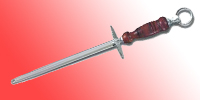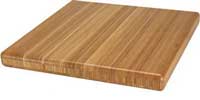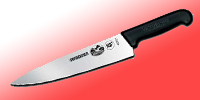Maintenance of Kitchen Knives
| Home |
Maintenance of Kitchen Knives
Maintenance of kitchen knives can be broken down into several parts.
Maintenance of blades, edges, handles, and storage



| Home |
Maintenance of kitchen knives can be broken down into several parts.
Maintenance of blades, edges, handles, and storage
blades are generally four types of materials:
1. carbon steel,
2. stainless steel
3. titanium alloy or titanium composite
4. ceramic
Carbon steel blades will require the most maintenance of all of the blade types. Because carbon steel blades have a low chromium content the blades will tarnish. Old timers have never considered this tarnish much of a concern because in the 1950 and before, almost all of the knives made fell into this category. To keep a carbon steel blade bright and shiny they must be cleaned and dried and oiled immediately after use. Not in a few hours, not the next day, but as soon as you are finished - clean, scrub, dry thoroughly, and lightly oil them to prevent tarnish. To clean good old soap and hot water is sufficient, dry thoroughly with a cup towel, (do not leave on a drain board) and then lightly oil with mineral oil to keep the blades from rusting.
Stainless steel is not quite as stainless as we would like or some users suppose, and should not be soaked and should be completely dried to prevent any rust tarnish spots from occurring. Stainless steel comes in various grades, the higher grade steels (and higher priced) with higher amounts of carbon and that hold the edge longer are usually more prone to spotting than are grades (that are cheaper) with lesser amounts of carbon. Stainless steel as in a kitchen sink will not rust but it will also not take or hold an edge, stainless steels that will harden and hold an edge are more likely to spot with water, bleach, and caustic detergents. If they are cleaned and dried properly and promptly, they should not need to be oiled as would carbon steel knives and will not generally spot with rust. Stainless steel kitchen knives should not be put in a dish washer regardless of what the manufacture direction recommend. See the second paragraph below for further information.
Titanium alloy, and ceramics are pretty much trouble free, scrub with hot soapy water and dry. Titanium and ceramic can be dried on the drain board, and will not rust.
Dish Washer - None of these knives regardless of type should be washed in a dish washer! A dish washer uses extremely hot water and caustic detergent, the wash cycle vibrates the edges against other silver ware, dishes and the baskets of the washer dulling fine edges, and the drying cycle uses very hot circulating heat and air. This combination can and will cause handle rivets to pop, edges to dull, and de-lamination of all wood and most synthetic laminate handles. The high extremes of heat and chemicals will spot stainless steel and destroy any edges. It is too violent an environment for your fine cutlery.
is a subset of the blade
1. Sharpening, for sharpening see our page on sharpening knives
2. Cutting surface, see our page on cutting boards
3. What you cut
What you cut, is as important as where and what you cut with. I shouldn't have to mention these simple facts but I have seen enough messed up kitchen knives that I guess it must be mentioned. Kitchen knives are thin, precision instruments designed to cut fruit, vegetables, and meat. They do not work well for prying can lids, prying frozen foods apart, cutting cardboard, whittling wood, digging weed from the yard, etc, etc, etc. They were designed to cut food and that is the only thing they should be used to cut.
Handles are generally made of three materials
and usually have one of three constructions.
Materials
1. wood
2. metal
3. synthetic
Wood handles requires the most work. Wood handles are absolutely beautiful when new and absolutely horrible a few months later if not maintained properly. Wood falls in to two categories, natural whole wood handles and laminated handles. Whole wood handles are slabs of wood straight off the tree cut and fit to the knife tang. Laminated wood handles are thin strips of wood that are glued together much like plywood. Whole wood handles if not maintained will split, crack, shrink, dry out, pop rivets, and produce splinters. They are easy to maintain with a few simple steps. Do not soak wood handles, clean and scrub with hot water, do not under any circumstance put them in the dish washer and every month or so depending on use, re-oil the handles with a light mineral oil, or oil that is designed for use on wood that comes into contract with food. Laminated handles are much tougher than whole wood but they too can be ruined by long soaks in water or subjected to the extremes of a dishwasher. Laminated wood handles are generally fine if washed, not soaked, dried, and kept out of the dishwasher.
Metal handles should be treated much the same as stainless steel blades, wash dry, keep out of the dish washer, dry on the drain board. They are almost trouble free except for spotting that can occur if they are soaked or put in the dish washer. If they look dingy, a scrubbing with metal polish will re-shine shiny areas.
Synthetic handles are almost trouble free. As with everything else, keep them out of the dish washer, synthetic handles with melt if they get close enough to the dish washer drying element or the stove burner. Most of the new high tech plastics are pretty tough, I recommend fully enclosed handles as they seem to stand up better than the riveted styles on some of the cheaper mass merchant brands.
1. Riveted / Full tang
2. Molded / hidden tang
3. Metal / welded
Riveted / Full tang is a time tested method of kitchen knife handle construction. It is basically some handle material such as wood, plastic, laminated, etc that is attached to the handle by rivets, bolts, screws, etc. You can usually spot this construction because in most instances you can see the tang exposed on the top and bottom edges of the handle (full tang construction). Because the tang is exposed, as these handle shrink, curl, or split - food partials and bacteria can set up residence in the openings and they will be almost impossible to clean or remove the grime. The National Sanitation Foundation (NSF) will not certify this style knife for use in the commercial food industry.
Molded / hidden tang are generally a high tech plastic material that is molded directly on to the handle tang between the blade and a butt cap. It completely seals the tang from exposure to the elements. It will not allow food or bacterial contamination to infiltrate your knife tang. It is my favorite handle style. Molded handles are the most trouble free and comfortable handle in my opinion. Although not a molded handle there is a hidden tang construction where the tang is inserted into a handle material and solidly epoxy in place, sometimes they are secured with a tight fitting epoxy glued butt cap, depending on its construction these can also be very comfortable to use and maintenance free as long as the handle material is not subjected to soaking and dish washer extremes. This type hidden tang design prevents bacterial infiltration as long as the handle stays sealed and tight.
Metal / welded are pretty much trouble free, they are generally welded to the tang and they do not allow contamination infiltration but to me they are not comfortable in the hand. Since metal handles are usually hollow, it takes some creative design to get them to balance properly. Also heat or cold transfer may be a problem if you are cutting a lot of hot or cold food products.
Storage how you keep your knives when not in use can be considered a maintenance item. Knives that are crowded in a kitchen drawer can be nicked and chipped from impacting on other knives and reaching to get them may especially be hazardous if edges or points are in the wrong orientation. Storage in a drawer is ok if you keep blade protectors or savers on the knife edges. Protective covers, cover and protect the knife edges from impacting other knives and from impacting your hand and fingers.
Knife storage in wooden block can also be satisfactory, however if you have young children keep the block well away from the counter edge so small fry can not reach up and pull a full block of razor sharp knives on to their heads. Also knife blocks that have the blades facing down may dull your edges as you pull the knife out and its edge drags along the block holding slot. Some blocks orient the edges horizontally and reduce some of the risk of dulling your sharp edges. One last thing to consider, never put dirty soiled knives back in the block until they are thoroughly cleaned, bacteria may set up a presence in the resulting dirty slots.